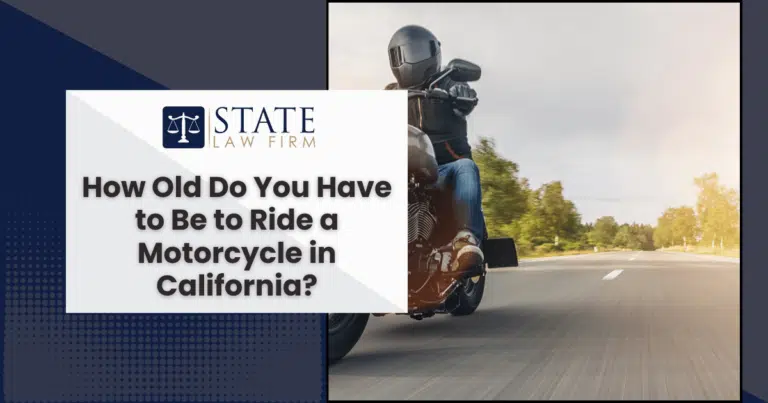From the scenic Pacific Coast Highway to the winding canyon roads of Los Angeles County, California offers some of the most iconic motorcycle routes in the country. It’s no wonder that many young riders are eager to hit the road. But before revving that engine, it’s crucial to understand the age requirements and legal responsibilities that come with riding a motorcycle in the Golden State—especially for those under 21.
According to the National Highway Traffic Safety Administration, in 2022 alone, motorcyclists were nearly 24 times more likely than passenger vehicle occupants to die in a crash per vehicle mile traveled. Source. That’s why California has implemented strict licensing procedures and safety regulations, particularly for younger riders.
At State Law Firm, we believe that knowledge is one of the most powerful forms of protection. As a boutique personal injury law firm based in Sherman Oaks, we’re passionate about helping our community stay informed and stepping in when things go wrong. If you or someone you love has been injured in a motorcycle or car accident, our Sherman Oaks car accident lawyers are here to help.
In this guide, we’ll walk you through the age requirements for riding a motorcycle in California, how to get licensed, essential safety gear, and key laws every young rider needs to know. Whether you’re a parent, a teen, or just curious about motorcycle laws in California, this article has you covered.
Understanding the Minimum Age Requirements for Motorcycle Riders in California
In California, the minimum age to ride a motorcycle on public roads is 15½ years old, but there are important conditions. Riders under 21 must follow stricter guidelines than older riders, including completing a certified safety course and fulfilling permit-holding requirements.
Here’s how it breaks down:
- At 15½ years old, you can apply for a motorcycle learner’s permit—but only after completing both driver’s education and driver’s training (DE/DT), and with parental or guardian consent.
- To ride legally with a motorcycle license (M1) in California, you must be at least 16 years old, complete the California Motorcycle Safety Program (CMSP) training course, and hold your learner’s permit for at least 6 months.
- Riders under 18 must also pass the DMV’s motorcycle knowledge test and keep a clean driving record.
Pro Tip: If you’re under 17½ and don’t already have a standard Class C driver’s license, you’ll need to complete driver’s ed and pass the standard driver’s test before applying for your motorcycle permit.
The Process of Obtaining a Motorcycle License in California: Step-by-Step
Getting your motorcycle license in California is a multi-step process, especially for younger riders. Here’s how to navigate it:
- Complete Driver’s Education & Training (if under 17½)
- Enroll in a DMV-approved program
- Pass the Class C driver’s knowledge test
- Take the CMSP Motorcycle Training Course (MTC)
- This program includes classroom and on-bike training sessions
- Upon completion, you’ll receive a DL 389 certificate
- Apply for a Motorcycle Learner’s Permit at the DMV
- Submit your DL 389
- Pass the DMV’s motorcycle knowledge test
- Hold Your Permit for at Least 6 Months
- Restrictions include: no riding at night, on freeways, or with passengers
- Upgrade to an M1 License
- After six months—or once you turn 21—you can upgrade your permit to a full motorcycle license
The CMSP course typically costs around $395 for riders under 21, and demand is high. Booking in advance is highly recommended.
If you or your child are navigating this process and something goes wrong—whether during a ride or dealing with insurance—our Sherman Oaks car accident lawyers are here to help with straightforward, aggressive representation.
The Importance of Safety Gear and Training for Young Riders
While the freedom of the open road is appealing, the reality is that younger riders face higher risks. That’s why California requires all motorcycle operators—regardless of age—to wear approved safety gear and encourages early training.
Required and recommended gear includes:
- A DOT-approved helmet (legally required)
- Protective gloves, jacket, and pants
- Over-the-ankle boots
- Bright or reflective clothing to enhance visibility
Training isn’t just a requirement—it’s a lifesaving investment. The CMSP course teaches core skills in hazard recognition, emergency braking, and defensive riding. According to the National Highway Traffic Safety Administration, motorcyclists are significantly more likely to suffer fatal injuries in crashes than those in passenger vehicles. Training dramatically reduces that risk (source).
Pro Tip: Even after getting licensed, consider taking advanced riding courses to continue developing safe riding habits.
Legal Responsibilities and Regulations for Young Motorcyclists Under 21
California holds young motorcyclists to a high standard for good reason. Between age-related crash data and rising vehicle density across the state, the law includes additional rules for riders under 21.
Key responsibilities and restrictions include:
- Permit Limitations: No freeway use, night riding, or carrying passengers
- Mandatory Insurance: Riders must carry proof of minimum liability insurance
- Zero-Tolerance DUI Policy: Any detectable blood alcohol content can lead to penalties, suspension, or even arrest
Violations may result in fines, license suspension, DMV points, or long-term insurance increases. At State Law Firm, we regularly handle cases involving young riders who were injured or wrongfully cited—and we’re ready to stand by your side if the need arises.
Additional Resources for Aspiring Young Motorcycle Riders in California
Learning doesn’t stop after the permit or even after getting your license. The best riders continue training and stay connected with the riding community.
Here are some helpful resources:
- California DMV – Motorcycle License Information
- California Motorcycle Safety Program (CMSP)
- Local riding schools like SoCal Supermoto and Ride Rite
- Youth-focused motorcycle clubs and mentorship programs
- Community riding events that promote safe, fun group rides
Pro Tip: Riding with a community isn’t just about fun—it helps newer riders gain experience, ask questions, and stay safer on the road.
If you or a loved one has been injured in a motorcycle or car accident, State Law Firm is here to help. Our Sherman Oaks car accident attorneys provide personalized, aggressive advocacy for riders and drivers across Southern California. We know what it takes to win the hard cases—and we fight like it’s personal.


